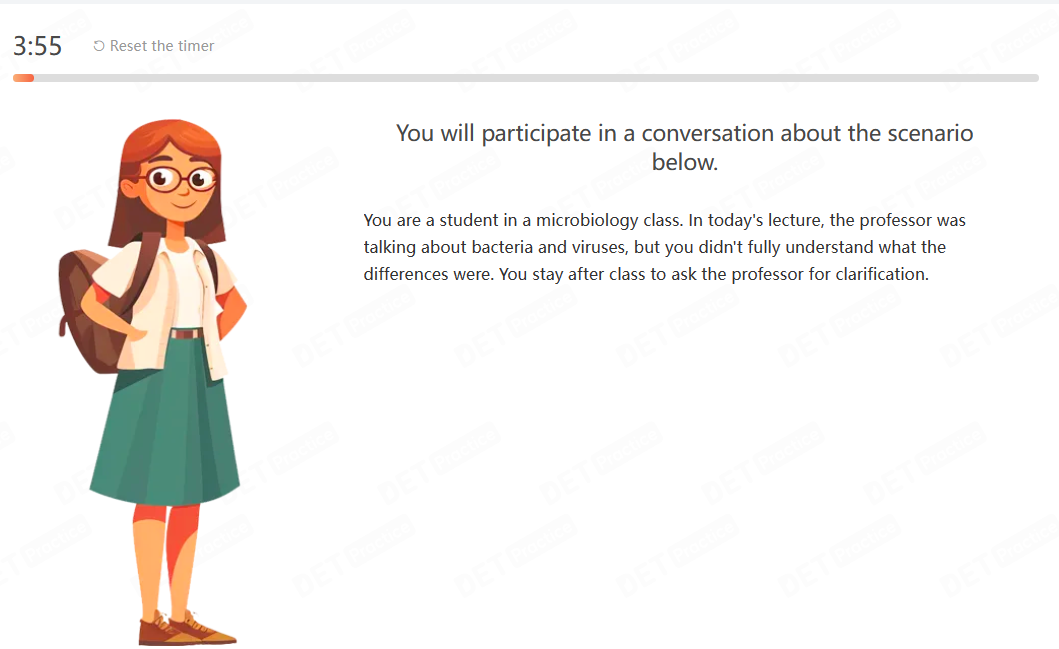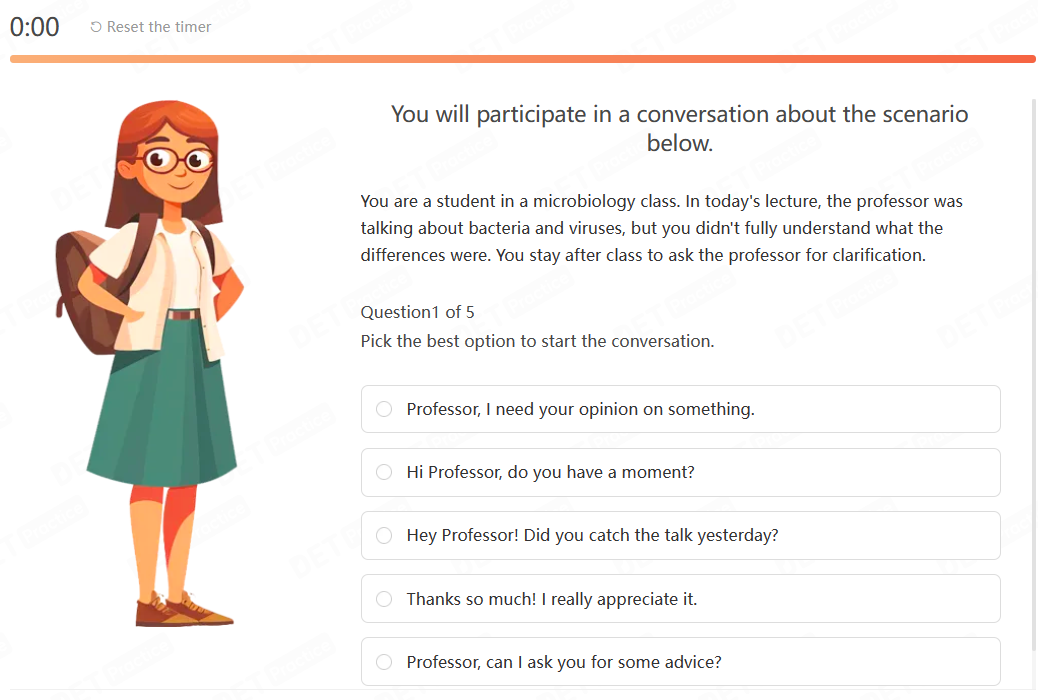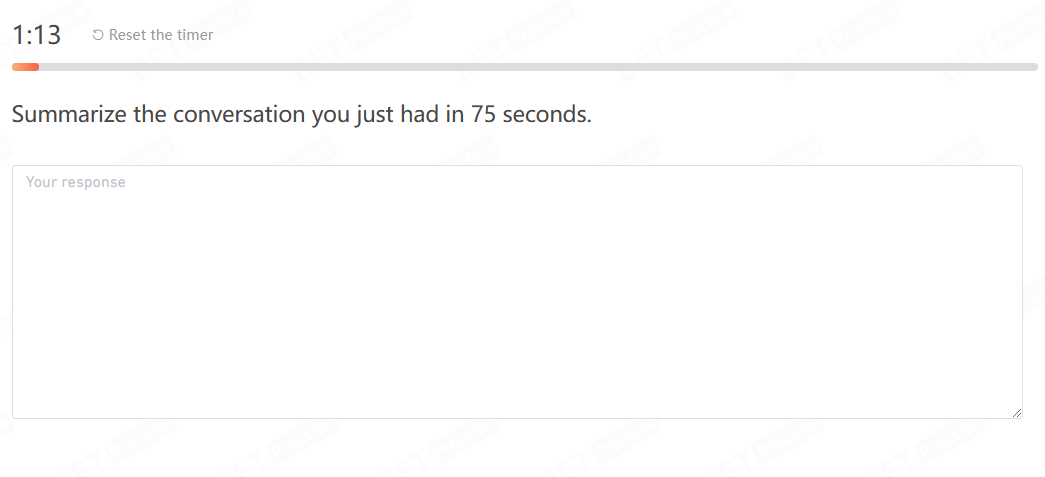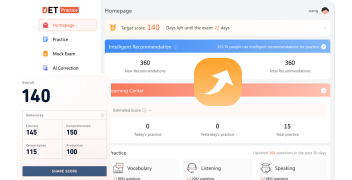Interactive Listening Made Easy: A Simple Framework to Nail the New DET Question Type
Hello everyone, welcome to DET Practice. Today we are going to talk about how to do the “Interactive Listening” questions. Unlike any articles that give general suggestions for improvement, we will give very specific and actionable advice and steps in this article. Please read carefully, and we believe it will help you get a higher score in “Interactive Listening”. Let’s get started!
Question Type Introduction
“Interactive Listening” is a new question type introduced to the Duolingo English Test in 2023 and updated in 2025. In this section, you will encounter several questions presented in sequence. There are three main types of questions:
1. Listen and Complete: In this part, you will hear a short scenario and need to fill in 3–4 sentences, which are presented as fill-in-the-blank questions.
2. Listen and Respond: This section consists of multiple-choice questions, each with 4–5 answer options. You have 4 minutes to complete this part.
3. Summarize the Conversation: Here, you are required to summarize the conversation, with 75 seconds allotted to answer.
If you’d like to learn more about “Interactive Listening,” you can watch this brief official introduction video below (starting at around 0:56):
Alternatively, if you prefer to read the text version, we also have a more detailed introduction to “Interactive Listening” in our other post: https://www.detpractice.com/det-question-type-interactive-listening
Note: This guide has been updated. You can find the latest version here: Duolingo English Test Interactive Listening – Complete Guide (New Version)
Listen and Respond
Unlike the listening questions in the TOEFL or IELTS tests, the “Interactive Listening” questions in DET will gradually display the listening scripts. Yes, you read that right. This means that for each question you choose, there will be a previous hint (Good news!).
l Let’s take a look at the question interface:

Before doing “Listen and Respond” each time, you will see the following Scenario. Let’s see what information this Scenario provides us:
a. You will participate in a conversation about the scenario below. (Note that, unlike traditional listening questions, you, as a test taker, will play one of the roles in this listening segment.)
b. You are a student in a microbiology class. (This tells you your identity.)
c. After today's lecture, you asked the professor about the difference between bacteria and viruses. (This mentions the problem you encountered and the person you asked for help or discussed with.)
At this point, we understand that this Scenario is actually a summary of the listening scripts in some form (we will continue to explain this part later). Then, this Scenario can also be used as a basis for judging the “Listen and Respond” questions.
l Let’s use a question as an example:

Quickly recall the Scenario we just saw. In this way, only option 5 is the most appropriate answer.
l Let’s continue to look at the question:

Here we see that your previous choices and the content you've heard will be displayed. This is helpful for test takers as it makes the questions easier.
How do we make choices? Remember the earlier Scenario? The examples show the purpose of the Scenario and the scripts that follow. This information can aid in answering the upcoming multiple-choice questions.
After the “Listen and Respond” section, you'll see all the listening scripts. As mentioned, you usually have 1-2 minutes left to answer. Use this time to review the text and memorize key points from the conversation, as the most challenging question, “Summarize the Conversation,” is coming up.
Summarize the Conversation
First, let’s take a look at the question interface:

This is a desperate scene. In this interface, except for reminding you that this question only has 75 seconds to answer, there is nothing else. Yes, you will not be able to see the previous listening conversation again. So, we can only write a summary of the listening conversation from memory. The difficulty of this question is that it requires a high level of short-term memory and typing speed for the test takers. How can we get as many points as possible in this question? First, here are some details to pay attention to:
1. Use the first person in the summary
2. Past tense and present tense will be the most commonly used tenses
3. Try to include as many details as possible from the listening conversation in the writing
If you have any questions about the above 3 points, you can watch the Sample Essay.

Answer strategies for most Test-Takers
l If your short-term memory is not very good, or your vocabulary foundation and listening ability are both weak, and you do not fully understand the content of the conversation, we suggest you stick to the Scenario. This Scenario is actually a summary of the listening conversation in some way (although it lacks some details). In the remaining time after completing the “Listen and Respond” part, please focus on memorizing the Scenario part and try to restore it in the later writing. Of course, it is best to paraphrase it in your own words, rather than directly copy the original text.
l If your typing speed is not fast enough, we suggest you go to typing.com or keybr.com websites to do 15-30 minutes of typing speed practice every day. For test takers with a short preparation time, we suggest that you master at least one writing framework for “Interactive Listening” before the test because if you still need to think about the writing framework in the 75-second answer time, you will not be able to write too much content.
If your English ability is not that good now, we recommend you try to use our suggested method to prepare or answer the questions. Good luck with your DET test!
Click here for more DET Preparation Strategies
Start practicing today by signing up for our DET question bank for free.






